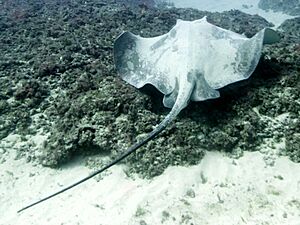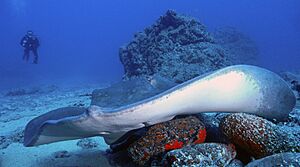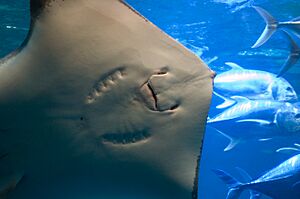Broad stingray facts for kids
Quick facts for kids Broad stingray |
|
|---|---|
 |
|
| Conservation status | |
| Scientific classification | |
| Genus: |
Bathytoshia
|
| Species: |
lata
|
| Synonyms | |
|
|
The broad stingray (Bathytoshia lata) is also known as the brown stingray or Hawaiian stingray. This type of stingray belongs to the family called Dasyatidae. You can find them across the Indo-Pacific region, from southern Africa all the way to Hawaii. They are the most common type of stingray in the shallow waters around the Hawaiian Islands.
These rays live on the ocean floor in sandy or muddy areas. They can be found in waters deeper than 15 meters (49 feet). At night, broad stingrays actively search for invertebrates (animals without backbones) and small bony fishes that live on the bottom. They often hunt near the edges of reefs. The broad stingray gives birth to live young. Sadly, there are many threats to their population in different parts of the world. Because of this, the IUCN (International Union for Conservation of Nature) lists them as a Vulnerable species.
Contents
About the Broad Stingray's Name
The broad stingray was first described by an American zoologist named Samuel Garman. He wrote about it in 1880 in a science magazine called Bulletin of the Museum of Comparative Zoology. He named it Trygon lata. The word "lata" comes from a Latin word meaning "broad."
Later, scientists decided that Trygon was actually the same as Dasyatis. So, the stingray's name changed to Dasyatis lata. The first broad stingray studied was found in what were then called the "Sandwich Islands" (now Hawaii). It was about 52 centimeters (20 inches) wide.
Where Broad Stingrays Live
The broad stingray lives in the eastern Atlantic Ocean and the Indo-Pacific region. This includes areas from southern Africa to the Hawaiian Islands. You can also find them in the Mediterranean Sea, with some sightings from Spain to Turkey.
These stingrays are often seen in coastal bays where the bottom is muddy or silty. They can also be found in sandy spots or near coral reefs. They usually live at depths between 40 and 200 meters (130–660 feet). However, they have been found as deep as 800 meters (2,600 feet)!
What Broad Stingrays Look Like
The broad stingray has a body shape like a diamond. Its body disc is about a fourth wider than it is long. The front edges of its body are mostly straight and meet at a wide angle. The back edges are curved. Its snout (nose) is rounded and sticks out a bit from its body.
Its mouth is curved and has five or six small bumps, called papillae, on the floor of its mouth. Two of these bumps are in front of the others. The fins on its belly, called pelvic fins, are short and round. The tail is like a whip and is at least twice as long as its body disc. It has a jagged, stinging spine on top, near where the tail connects to the body. There's also a long, narrow fin-like fold underneath the tail. This fold eventually becomes a ridge that goes all the way to the tip of the tail.
Older, larger rays have three big, long bumps in the middle of their back. Their tail feels rough because of tiny skin teeth called dermal denticles. They also have a bumpy row of cone-shaped bumps on each side of the tail and some large, flat bumps in front of the spine.
Broad stingrays are usually plain olive to brown on top and white underneath. Another stingray that looks similar is the diamond stingray. It lives near Hawaii too, but its tail is shorter and has both upper and lower fin folds. Broad stingrays can grow up to 1.5 meters (5 feet) wide and weigh up to 56 kilograms (123 pounds). However, most are usually less than 1 meter (3.3 feet) wide.
How Broad Stingrays Live
During the day, broad stingrays are not very active. They often spend their time lying partly buried on the ocean floor. Scientists tracked some rays in Kaneohe Bay and found that they moved around a lot more at night. At night, they covered an average area of 0.83 square kilometers (0.32 square miles). During the day, they only used an average area of 0.12 square kilometers (0.046 square miles). They didn't rest in the same spot every day.
Rays were most active about two hours after sunset and before sunrise. They were also more active in the warmer water temperatures of summer than in winter. The ocean tides didn't seem to affect their behavior much, probably because they live in deeper water.
Broad stingrays mostly eat crustaceans (like crabs and shrimp) that live on the bottom. They also eat polychaete worms and small bony fishes. They dig large pits to find buried prey. Other fish, like jacks, sometimes follow them to snatch up any food they uncover. When hunting, rays prefer areas close to reef edges. Many parrotfish, wrasses, and gobies hide in these areas at night.
Like other stingrays, broad stingrays give birth to live young. Kaneohe Bay seems to be a special "nursery" area for these rays. Young scalloped hammerheads and broad stingrays are the main hunters there. Off the coast of North Africa, broad stingrays give birth in June and December. This might mean females have two litters a year, or that there are two groups of females, each having one litter a year.
Broad Stingrays and Humans
The International Union for Conservation of Nature (IUCN) used to consider the broad stingray as "Least Concern." But in 2021, its status was changed to "Vulnerable." This is because scientists don't know how much of its living area is protected by marine protected areas. This species has also become a popular animal to see at public aquariums and resorts.
Images for kids






